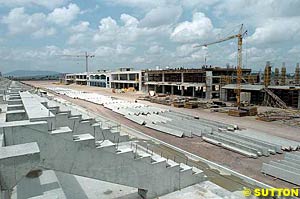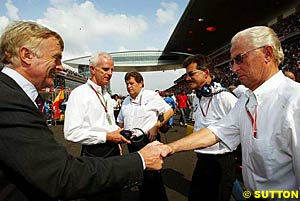Atlas F1 Magazine Writer
Fresh from the Formula One paddock
FIA President Max Mosley's suggestion at Shanghai that the 2005 Formula One World Championship would be contested over just 17 rounds is no shock, for this year's 18-race calendar was deemed by most to contain one Grand Prix too many, and speculation that next season's schedule would run to 19 was greeted in many quarters with horror.
The more events, the less the testing - with subsequent savings by the sport - was the reasoning behind an expanded calendar. However, as proven so often, attempts at curbing F1's out-of-control costs have too often had the opposite effect, particularly amongst the Big Four teams. And, with F1 gradually but surely moving out of Europe, additional events would most likely have been fly-aways, adding even more expense to the independents - Sauber, Jordan and Minardi.
A 19-event calendar would appeal to SLEC, F1's commercial rights holder, as it would receive increased hosting fees. Estimates put these between $20m and $40m per event over and above 17 Grands Prix, so very attractive amounts would accrue to SLEC via the additional events. Equally, television contracts containing 19 blocks of three hours each offer SLEC a six-hour premium over 17-event championships, whilst broadcasters have extended recovery periods via increased advertising blocks over the season.
Pragmatically, 17, or even 19 events go nowhere close to the sport's saturation point, which kicks in at 20 or so events per season from a viewer perspective. By the same token, the 16 races of 2003 left too many empty Sundays, so the ideal compromise would appear to be the 18 of this year, even if this mid-season was fraught with hectic logistics.
But, a return to just 17 events (as per 2002) would appear to be on the cards for next season if Mosley's indications are correct. But the calendar is unlikely to look the same as in 2002, as Bahrain and China have joined since and Austria has departed. Then there is talk that Turkey will join next year, adding further pressure to 'traditional' circuits to maintain their place in F1's sun.
So, assuming 17 races, and assuming the debut of Turkey, who goes and who stays?
Contractual situations skew this analysis, but, as proven by issues surrounding Canada and Austria, Formula One Management's contracts contain clauses permitting cancellation under certain conditions, so existence or duration of a contract does not guarantee safe passage for all events. Equally interesting is the recent trend by FOM to enter into seven-year deals in place of the tradition five season blocks existent a few seasons back - a development no doubt influenced by the rise of the GPWC and its threats to FOM. After all, which circuit, once committed to F1, could afford, in both the legal and financial senses, to host a GPWC race?
This was a trick learned by Ecclestone during the early eighties' FOCA/FISA war, when he tied up various circuits to deal with him exclusively, and the tactic played an invaluable role in his subsequent control of F1.
So, here are the circuit survival ratings, in 2004 order, where 10 = Safe and 0 = Extinct:
Melbourne, Australia: Safe as the Australian economy. Ron Walker runs a superb show, the State of Victoria pays the bills on time and exempts tobacco for four days each year despite some of the most Draconian anti-smoking laws on earth. The early morning slot (for Europe) suits the sport as it pulls audiences out of winter hibernation, and teams love the place. (9)
Sepang, Malaysia: Considered safe - certainly for as long as its government believes the tourism income exceeds its hosting fees, promotion costs and track maintenance. That Malaysia allows tobacco advertising is a bonus, whilst its proximity to Australia reduces fly-away costs. (8)
Sakhir, Bahrain: Bahrain is in the same situation as Malaysia, even if the attendance at the inaugural race was low. The time zones work in its favour over April. (9)
Imola, Italy: Wobbly, not least as Italy has two events, it competes (and loses) against Monza for the sport and nation's affections - notwithstanding its emotional overtones. Attendance is the poorest of all European events, even if on a par with Bahrain's live numbers – which is no excuse from FOM perspective. That this 'quaint' circuit with antiquated facilities allows tobacco in exchange for negligible fines paid 'upfront' probably won't help the track, especially now that its contract has expired. (2)
Catalunya, Spain: Safe. The local government allows tobacco advertising, F1 is on the up in Spain due in no small part to Fernando Alonso, the circuit meets every standard, plays to a full house, and received local and state injections when required. (8)
Monte Carlo, Monaco: Despite its questionable facilities and circuit standards, Monaco is safer than any other due to tradition and sponsor pressures, and the fact that certain factions would hate even the remotest chance of it hosting a GPWC event. Its status is assured by one small detail: F1 builds its entire schedule around the date of Ascension Day, which equals Monaco Thursday... (10)
Nurburgring, Germany: The 'Newburgring', with renewed contract in place, has added seats and stands and is home event for Michael Schumacher, Mercedes-Benz and BMW. The place is safe for a few years yet despite terrible access, iffy weather and being Germany's secondary event. (6)
Montreal, Canada: A year ago this North American event wobbled chronically, but then promoter Normand Legault desperately offered FOM compensation for the loss of tobacco livery through legislation. This upped fees applicable to other F1 events, to Ecclestone's eternal gratitude. (7)
Indianapolis, USA: Safe from FOM's perspective, but semi-safe from where promoter Tony George's Indianapolis Motor Speedway stands, for the Indy heir runs three blue-riband events each year – the 500, the 400 NASCAR race, and the GP – and loses on one... That fly-away costs are now shared with Montreal makes the event more viable for the teams, but George's fortune can take only so many hits. (9 from FOM's perspective; 5 from IMS's)
Magny-Cours, France: Safe for now, contingent upon the circuit repaying its accumulated debts, but thereafter? That it is controlled by Jacques Regis, who challenged Mosley at the FIA in July, may count against it; that France gave so many words to motor sport's vocabulary works in its favour. (6)
Silverstone, Great Britain: Every year Silverstone is the butt of Ecclestone's wrath (see July 14th's Weekly Grapevine) but it's seldom justified when measured against certain other circuits. Silverstone, nonetheless, has a funding crisis, and for as long as the likes of Bahrain and China are willing to pay double the going rate to host a GP, the less the likelihood of Silverstone's safety. A BRDC source advises the club is willing to break even on the BGP but refuses to go into red figures, and that is the likely scenario with Ecclestone's present demands. F1's first-ever World Championship circuit is far from safe. (1)
Hockenheim, Germany: Safe whilst Schumacher, BMW and Mercedes remain in the sport, particularly as the local government and town council have pledged funds to retain the event. (8)
Budapest, Hungary: The first non-traditional event, and so much a fixture since 1986 that its status is now 'traditional'. The Hungaroring is not endangered for as long as Budapest pays and it allows tobacco advertising. (7)
Spa-Francorchamps, Belgium: Will the circuit's 'classic' status be kept after the triple debacles (See August 4th's and September 1st's Weekly Grapevine) of its return this season? The FIA will shortly convene to hear the police matter and any other business, but, either way, this traditional Grand Prix is endangered. (3)
Monza, Italy: This shrine to Grand Prix racing will remain on the calendar for just as long as Ferrari remain in Grand Prix racing. (8)
Shanghai, China: Second in the safety rating only to Monaco for the next six years, on account of its future potential and government funding. Put differently, would you cast aside $40m in exchange for $15m? (9)
Suzuka, Japan: Said to be in danger as its contract, which expires this year, has not been renewed, but Ecclestone always was a past-master at finding pressure points to up his antes. For as long as Bridgestone, Honda and Toyota, plus sundry partners, suppliers and sponsors, remain in F1, so does Suzuka. (8)
Interlagos, Brazil: This antiquated circuit, for which FOM and the FIA make 'special cases' on account of Brazil's rich F1 heritage, is safe for the next two years, after which it faces enormous pressures to upgrade what is a run-down circuit situated in slummy surroundings. For now, its time zone, bringing F1's season finale into European living rooms at prime time, counts volumes, but any (North or South) American circuit could fulfil the same role. (6)
So, the Survival Ratings summary:
10 – Monte Carlo
Draw you own conclusions on exclusion(s) from the 17-race 2005 calendar, and don't forget to add in Turkey.
Whilst on the subject of survival, just how many motor manufacturers will remain in Formula One over the next three years or so?
It is a truism of F1 that preparations for entry take many years, whilst decisions to depart require mere seconds. And, as Jaguar's notice proved, the repercussions can be considerable. Moreover, as with the Limping Cat, no team is immune from the irrationality that so often accompanies board decisions.
So, who could be the next to go?
BMW, too, has made threats to withdraw from the sport if they find the technical regulations no longer suitable, and inherent in the German manufacturer's threats is the possibility that it will depart F1 should V8s be enforced, for BMW has just introduced its M5 sports sedan with V10 power.
But, generally, manufacturer threats are seen as positive, for they prove powerful concern over the direction of the sport rather than pure disinterest, as was the case with, for example, Peugeot, which upped and offed without as much as whimper, or Yamaha, which slunk away ignominiously.
Seen in that context, Renault's recent behaviour has been rather interesting to observe, not least because it is known that Flavio Briatore is set to depart the team come the end of 2005.
Enough has been said of his outbursts during Shanghai's Thursday's FIA Press Conference, during which he called 'disgusting' the fact that F1 Racing's editor in chief, Matt Bishop, had the temerity to show interest in Jaguar's fate. The comments may indicate a deeper problem, for, come March next year, Renault Chairman and CEO Louis Schweitzer stands down in favour of Carlos Ghosn, presently CEO of Nissan of which Renault controls 44%.
Now, Ghosn is no great fan of F1 and could well pull the plug on Renault's activities, particularly if the team end the season behind BAR-Honda in the Constructors' Championship, as seems highly likely after Briatore's decision to sack Monaco winner Jarno Trulli. This year, apart from a standard-setting launch system which enables Renault to punch above their weight in the opening stages of the race, the team's pace is hardly that of a team which fancy themselves as favourites for the 2005 Championship.
Sources within the company predict that Renault F1 President Patrick Faure, once considered a candidate for Schweitzer's job - in the days before Ghosn engineered a miraculous turn-around for the ailing Japanese company - will either accept the post of CEO at Renault under Ghosn's Renault and Nissan presidencies, or move on. Either way, the man whose been the team's driving force for so long at Renault board level, the man who rubber-stamped Briatore's management decisions, will be lost to Renault F1 at the very time the team need all the board support they can muster.
Before Ghosn reformed Nissan, it had been said that no foreign CEO could survive the insular culture of Japanese business. Then this quintessential global leader — born in Brazil of Lebanese parents and educated in France — was dispatched by Renault to rescue its stake in Nissan. He closed plants and shed workers to take the company from a $5.6 billion loss in 2000 to a $2.5 billion profit a year later. If he could do it in unionised Japan, the old Benetton team do not stand a chance should he decide to close it.
So could it possibly have been an attempt to prevent pertinent questions with regard to Renault's future, that lead Briatore to bulldoze the FIA Media Conference away from Jaguar's crisis?

 In addition, fatigue would hit crews, and teams estimate that additional race staff - working on rosters - would be required to cater for increased workloads. The teams rejected suggestions that their test crew could be deployed in race positions, for testing would never grind to a halt until banned in part or totally by the regulations. To do so would require unanimous agreement by the teams, and with Ferrari having access to a custom test track on their door step - and two others within a few hours' drive of Maranello - F1 has more chance of seeing Jarno Trulli back at Renault than of restricting such non-competitive activities.
In addition, fatigue would hit crews, and teams estimate that additional race staff - working on rosters - would be required to cater for increased workloads. The teams rejected suggestions that their test crew could be deployed in race positions, for testing would never grind to a halt until banned in part or totally by the regulations. To do so would require unanimous agreement by the teams, and with Ferrari having access to a custom test track on their door step - and two others within a few hours' drive of Maranello - F1 has more chance of seeing Jarno Trulli back at Renault than of restricting such non-competitive activities.
9 – Melbourne, Sakhir, Indianapolis (?), Shanghai
8 – Sepang, Catalunya, Hockenheim, Monza, Suzuka
7 – Montreal, Budapest
6 – Nurburgring, Magny-Cours, Interlagos
3 – Spa-Francorchamps
2 – Imola
1 – Silverstone

 BMW and Mercedes-Benz have both threatened litigation against the FIA should it impose 2.4 litre V8 engines, in place of the 3.0 litre V10s, from 2006 in contravention of the Concorde Agreement, which specifies the latter format until the end of 2007. Honda, too, has threatened legislation or withdrawal (see Atlas F1's interview with Honda's Shoichi Tanaka) should F1's road map be in conflict with its own directions. In fact, it is thought to be exactly the latter possibility which led to Jenson Button's management invoking a get-out clause in his contract, which specified that BAR should have access to full manufacturer-backed engines if it wished to retain the Brit.
BMW and Mercedes-Benz have both threatened litigation against the FIA should it impose 2.4 litre V8 engines, in place of the 3.0 litre V10s, from 2006 in contravention of the Concorde Agreement, which specifies the latter format until the end of 2007. Honda, too, has threatened legislation or withdrawal (see Atlas F1's interview with Honda's Shoichi Tanaka) should F1's road map be in conflict with its own directions. In fact, it is thought to be exactly the latter possibility which led to Jenson Button's management invoking a get-out clause in his contract, which specified that BAR should have access to full manufacturer-backed engines if it wished to retain the Brit.
|
Contact the Author Contact the Editor |
Please Contact Us for permission to republish this or any other material from Atlas F1.
|
Volume 10, Issue 39
Atlas F1 Exclusive
Interview with Vitantonio Liuzzi
Interview with Paul Stoddart
Bjorn Wirdheim: Going Places
Ann Bradshaw: Point of View
2004 Chinese GP Review
2004 Chinese GP Review
Technical Review: China
The Confidence Trick
Stats Center
Qualifying Differentials
SuperStats
Charts Center
Columns
The F1 Insider
On the Road
Elsewhere in Racing
The Weekly Grapevine
> Homepage |
